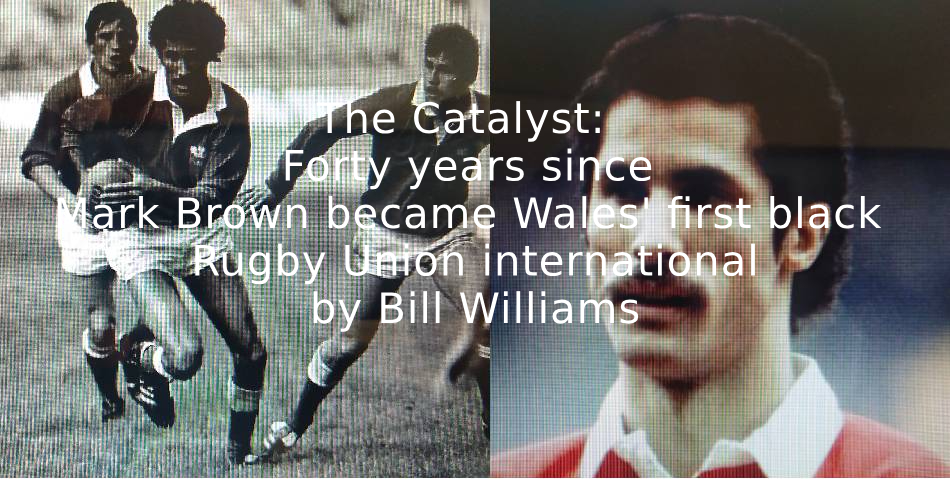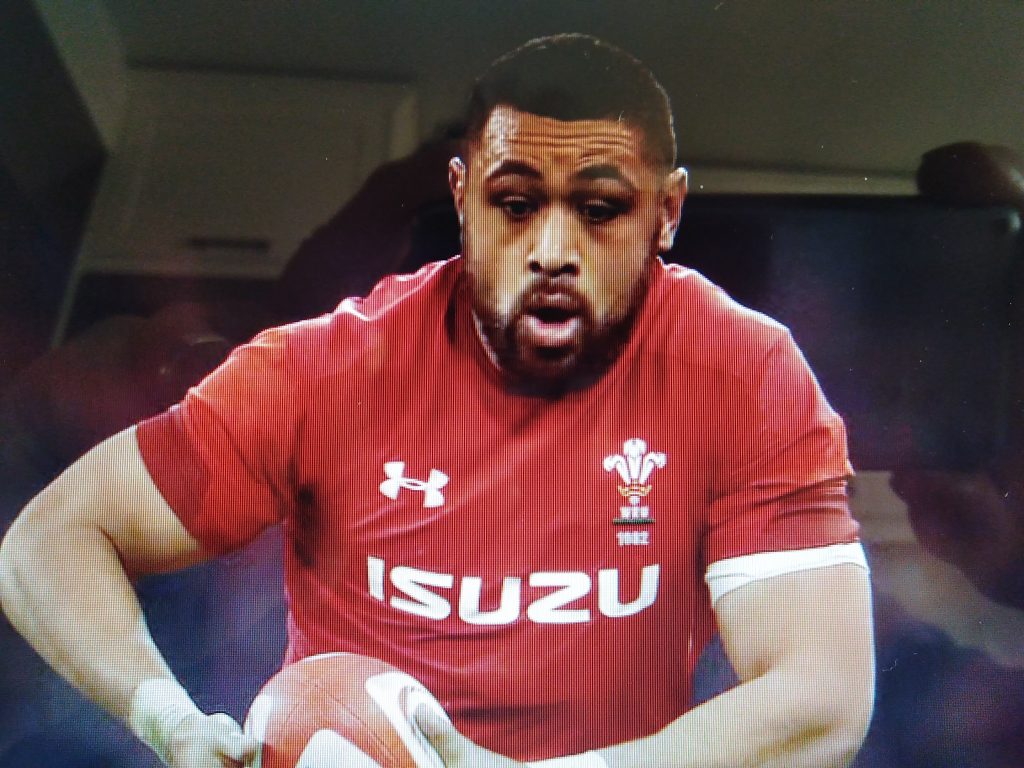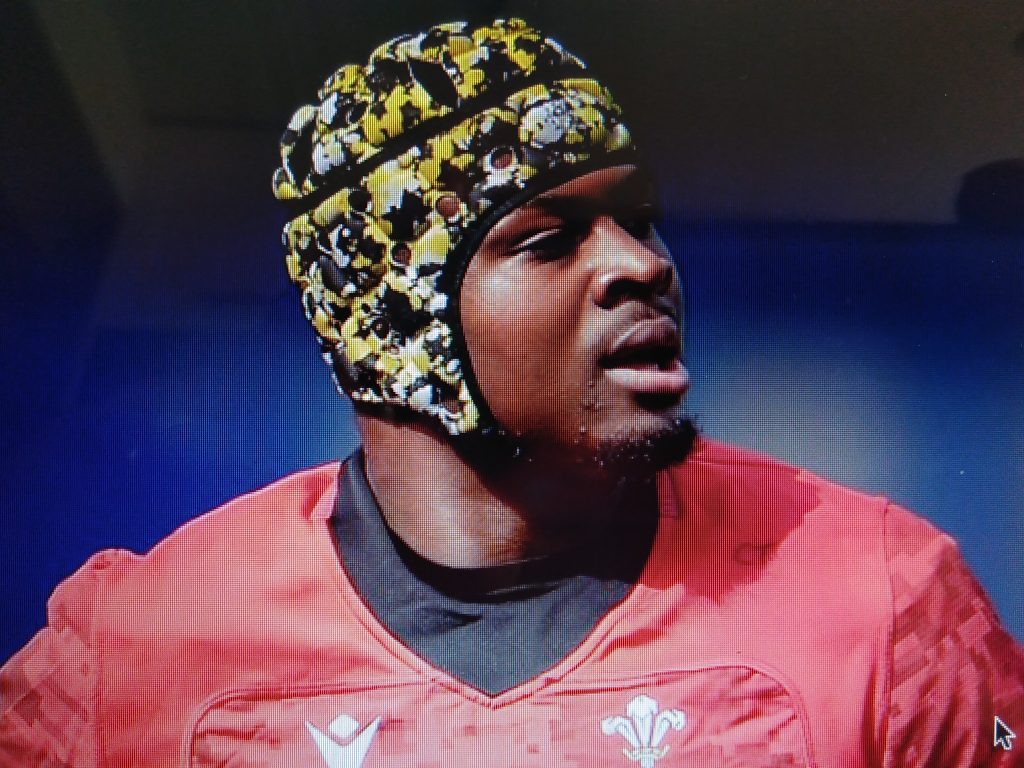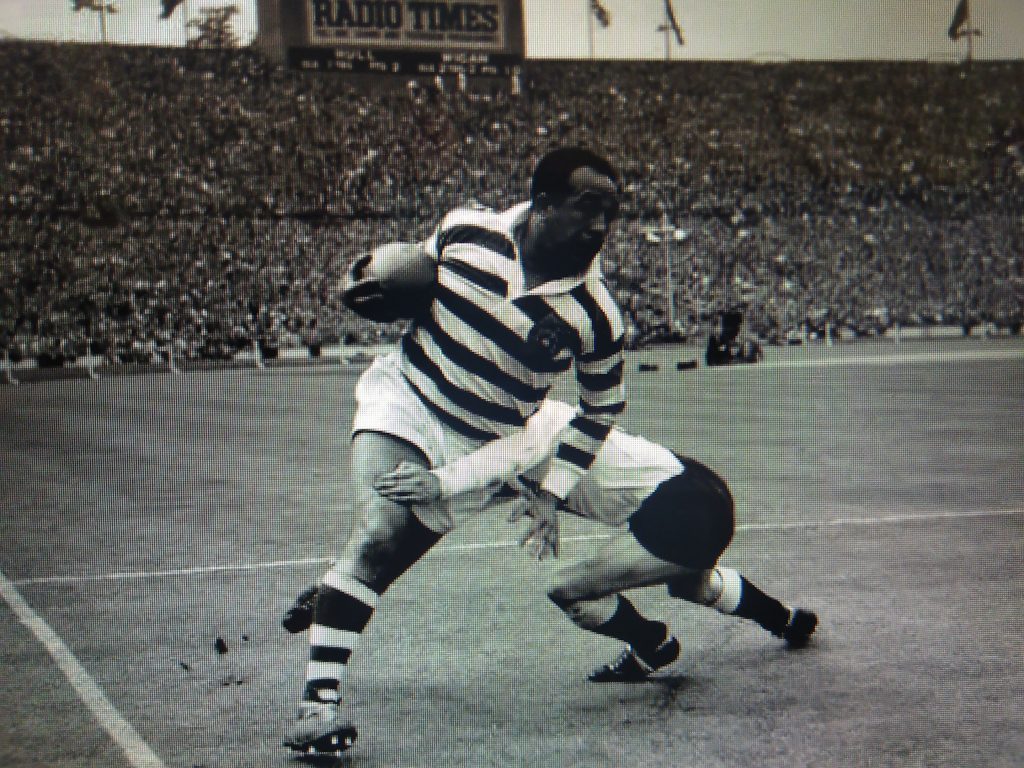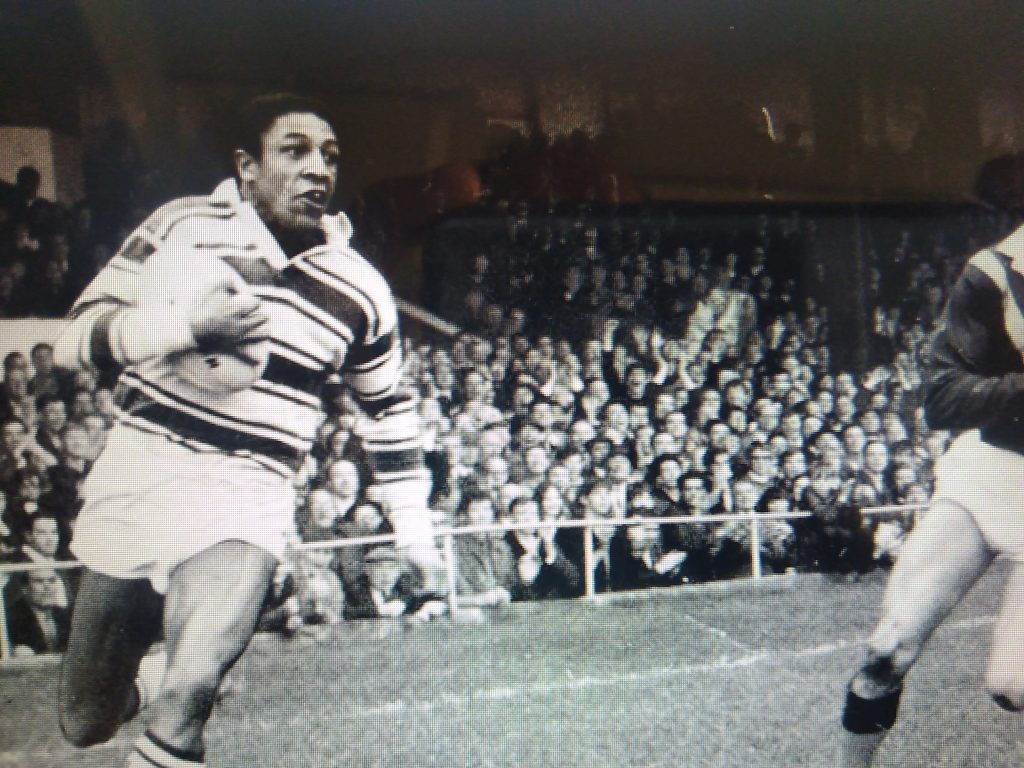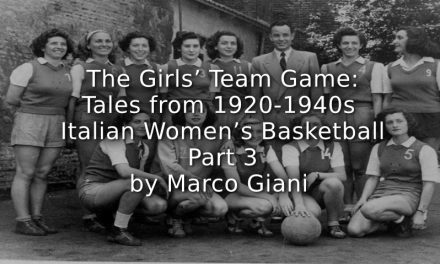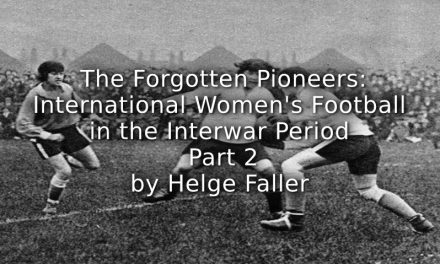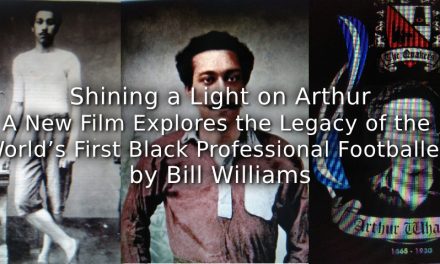When Wales play Argentina in their RWC 2023 Quarter Final on Saturday 14th October in Marseille they are likely to include two black players both of African heritage; Christ Tshiunza, born in The People’s Republic of Congo and Rio Dyer born in Newport and of mixed heritage. Sadly, Taulupe Faletau born in Tonga, will miss the match through due to an injury. All three players are now regulars in the Welsh squad and have all played at this year’s RWC in France.
- Faletau
- Tschiunza
- Dyer
However, surprisingly it is only forty years since Mark Brown became the first black player to be selected for Wales at Rugby Union and there is no question that he blazed a trail for the players that came after him who got to wear that famous red shirt.
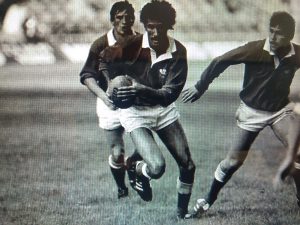
Mark Brown in action for Wales in 1983
Mark Brown, therefore holds a unique place in the history of the sport in Wales, as in 1983 he was selected to play against Romania in Bucharest becoming the first player of black heritage to play Rugby Union for Wales.
Born in Pill near Newport of a white mother and a father from Jamaica (a member of the ‘Windrush Generation’) Brown progressed through the club system ending up at Pontypool alongside the likes of Wales and British Lions greats, Graham Price, Terry Cobner and Bobby Windsor.
After an impressive performance for the club in the 1983 ‘Schweppes Cup’ final, the flanker was soon on the WRU’s radar and was selected to play in the ill fated match against Romania, which unfortunately ended in a 24-6 defeat. Nevertheless, further caps followed in the 1986 ‘Five Nations’ with appearances against England and Scotland and then in all three tests on Wales’ South Seas Tour that summer.
Now 64 Brown has had time to reflect on his achievements:
My pride at having played for Wales is pride in itself, not specifically to do with having been the first black man to do it; it’s almost something that seems to have been more important to other people than to me
Nevertheless changes had begun to take place and following hot on his heels was Bridgend’s Glen Webbe who became the first British player to score a hat-trick of tries at the inaugural RWC in 1987.
Glen Webbe, ‘Wales’ first black icon, circa 1986
Webbe would gain 10 caps for Wales and has often been described as ‘Wales’ first black icon’ and when his international career was over he continued to play for Bridgend scoring over 300 tries in 400 games/
Since that historic match in 1983 no fewer than 24 players from black or Polynesian backgrounds have represented Wales in the Union game and names such as Nigel Walker, Hemi Taylor, Scott Parker, Leon Brown and Colin Charvis to name but a few, are now part of Welsh Rugby’s rich and varied history and have Mark Brown to thank for being the catalyst for this movement that took so long to emerge.
Players of black and mixed heritage have played the game in the UK since it started to take shape in the late 19th century and Alfred Clunies-Ross, in fact became the first non-white player to play International rugby when he represented Scotland in the very first international match against England in 1871!
He was born in The Cocos Islands in the Pacific, but his father’s family had originated from The Shetland Isles and he had been educated in Scotland along with his brothers and studied at St Andrews and Edinburgh Universities.
The nation however, would have to wait until 2010 for the first player of African heritage to be capped, when Joe Ansbro gained the first of his 11 caps against South Africa.
The Scottish Rugby Union have inducted all twenty Scottish players who were involved in the first rugby international, in 2021.
Jimmy Peters was the first black player to represent England in 1906 and gained 4 caps between 1906 and 1908, but it would take 82 years before Chris Oti would gain the first of his 13 caps, when he became the second black player to play the union game for England.
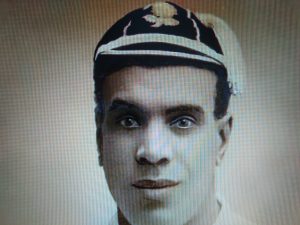
Jimmy Peters- England’s first black international 1906
So why did it take so long for a black player to be selected at international level in Wales?
As the game of rugby split in 1895 into Union (amateur) and League( professional), the Welsh Rugby Union founded fourteen years earlier, was caught up in the cross-fire with Wales having far more in common with the working classes in the North of England than the Oxbridge dominated South.
However, joining the Northern Union (which would become ‘The Northern Rugby Football League’ in 1922), would have meant the end of international competition for Wales at that time , with the Home Nations Championship having been launched in 1882/83; so they decided to defer to the RFU.
This wasn’t really an issue for Wales’ small educated middle classes who could afford to play for fun, but for the manual workers in the industrial south in the 1920’s and 30’s, being talented at rugby could be the only way to feed your family and players were starting to look to ‘The North’ and Historian Gareth Williams believes that over 70 Welsh internationals made the decision to move and between the wars there were possibly as many as 900 uncapped players who left Wales.
Arguably though the most devastating outcome of this however, was the ignorance in Wales, of the rich history of the games’ black players, who didn’t go north purely for the money but because in Wales they were arguably never going to get the opportunity in Union.
One such player was George Bennett who left Wales in the late 1920’s joining Weston and then Wigan but The WRU’S Heritage Manager Peter Owens believes that Bennett’s move ‘was driven by poverty rather than prejudice’
Bennett would gain 3 caps for Wales at Rugby League (RL) in 1935/36 and would become the first black man to represent a British national team at RL, but would be omitted from the British Isles tour of Australia in 1936 due to the colour of his skin!
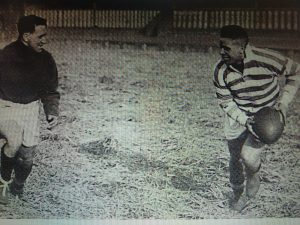
George Bennett training at Wigan circa 1935
Many would follow and journalist Carolyn Hitt researching for the acclaimed BBC documentary, ‘The Rugby Code breakers’ first shown in 2018, remembers realising that her research was, ‘Much a story of Welsh social history as sport, exploring the impact of class, racial prejudice and devastating economic change on the game at the heart of Welsh identity!’
She went on to comment on the fact that players were heavily criticised for ‘taking the money’, but when you consider the peak periods for losing players coincided with the most difficult times for Welsh industry- the inter wars years and the early 1980’s, ‘How could anyone blame them for using their special gifts to secure their families financial futures?’
It’s not surprising then to learn that The Wales RL team won three consecutive European Championships in the 1930’s, while The Union team struggled to win a Triple Crown between 1911 and 1950!
Many players who made the decision to move became icons of RL and names like Roy Francis, Johnny Freeman, Gus Risman, Colin Dixon, Billy Boston and Clive Sullivan are revered names in the north of England but are barely known in their homeland!
Three of these players, Risman, Boston and Sullivan all born in Cardiff however, have recently been honoured in the city of their birth with a magnificent statue celebrating their achievements, which was erected in July 2023 in Cardiff Bay and the inclusion of Boston and Sullivan marks the first ‘non-fictionalised’ named black men in Wales to be celebrated by a statue.
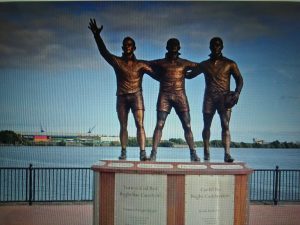
The statue of Rusman, Boston and Sullivan in Cardiff Bay- July 2023
Boston had dreamed of playing for Cardiff and Wales, but when he was offered £3,000 (£100,000 in today’s money) by Wigan RL in 1953, he apparently burst into tears because he knew that signing would mean that he would no longer be welcome in the Rugby Union clubs of South Wales and beyond. He signed nevertheless and went on to become one of the greatest try scorers in RL history with 571 in 562 matches. He would become the first black man to tour with Great Britain and was a member of the team that won the RL World Cup in 1954.
Clive Sullivan was another boy from Cardiff who caused a stir in the north of England becoming the first black man to captain a British Rugby team, winning the RL World Cup in 1972 and scoring the winning try. Interestingly, thirty years later, his son Anthony switched codes in the opposite direction and moved from St Helens to Cardiff and achieved 2 caps for Wales in 2001.
- Boston c 1954
- Sullivan c 1972
Peter Owens believes that it was not really that surprising that it took until 1983 to finally cap a player with black heritage as until the mid 60’s the number of black players playing in Wales was small and those playing for ‘first class clubs’ smaller still.
There was certainly prejudice against black players in Welsh rugby and that prejudice was of course absolutely wrong, but it was present not only in rugby in Wales, but in virtually every other sphere of British life
Says Owens who has been the WRU’S Heritage Manager since 1989.

Peter Owens – The WRU’s Heritage Manager
Also, due to the socio-economic backgrounds of many black families, Owens feels that it was difficult for people of colour to break through the barriers which existed in the mid 20th century.
Young black players became relatively easy prey for the cash rich Northern clubs, so many went North at a young age, often before they were able to realise their potential in the Union game
commented Owens, he added that
RL has often been portrayed as the game that offered opportunities for all players regardless of colour, but what happened to George Bennett in the 1930’s when he did not go on the British tour to Australia to ‘avoid criticism’ and the verbal abuse he and other black players suffered from opposition crowds, suggests that portrayal is flawed
Thankfully those attitudes are now a thing of the past in both Rugby codes and when the Welsh team run out for their RWC Quarter final, the crowd will get behind all players wearing the famous red shirt, irrespective of their colour and will perhaps spare a thought for Mark Brown who forty years ago was the catalyst; maybe he deserves a statue too.
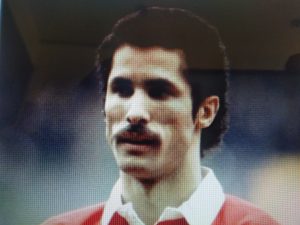
Mark Brown- Welsh International 1983-86- 6 caps
Article copyright of Bill Williams

